Graphene and its Applications. Study on The Development Trends in Research and on the Implementation Potential using Big Data and Information Refining Methods
Article Information
Aleksander Zolnierski1, Wieslaw Cetera2*, Dariusz Jaruga2, Jan Grzegorek2, Grzegorz Sowula3
[1]Institute of Economics of the Polish Academy of Sciences (Staszic Palace, 72 Nowy Swiat St., Room. 266, 00-330 Warsaw), Poland
2The Faculty of Political Science and International Studies (Krakowskie Przedmiescie 26/28, 00-928 Warsaw), Poland
3The Faculty of Management at the University of Lodz (22/26 Matejki Street, 90-237 Lodz), Poland
*Corresponding author: Wieslaw Cetera, The Faculty of Political Science and International Studies, Krakowskie Przedmiescie 26/28, 00-928 Warsaw, Poland.
Received: 20 July 2022; Accepted: 25 July 2022; Published: 19 August 2022
Citation: Aleksander Żołnierski, Wiesław Cetera, Dariusz Jaruga, Jan Grzegorek, Grzegorz Sowula. Graphene and its Aapplications. Study on the Development trends in research and on the Iimplementation Potential using big data and Information Refining Methods. Journal of Nanotechnology Research 4 (2022): 117-124
View / Download Pdf Share at FacebookAbstract
This paper presents the results of a study on development trends for graphene technologies and on the applications of this material, which is a dynamically growing field of Nano technological research. The study uses information refinement methods and analytical methods using big data tools, as well as statistical methods and machine learning-based algorithms. The aim of the study was to determine the potential of graphene application and identification of change trends in this field, based on the previously defined fields of technology. The results of the study indicate the potential of analytical tools - the greater the more specific, specialized knowledge in the field is involved. The study identified trends related to graphene applications, mainly in the field related to energy solutions. Research dedicated to applications in electric engineering include not only batteries, but also transistors, magnetic field sensors, fuel cells, electric conductors and generators.
Keywords
Big Data; Information Refine; Graphene; Information Management; Innovation; Nanotechnology
Big Data articles Big Data Research articles Big Data review articles Big Data PubMed articles Big Data PubMed Central articles Big Data 2023 articles Big Data 2024 articles Big Data Scopus articles Big Data impact factor journals Big Data Scopus journals Big Data PubMed journals Big Data medical journals Big Data free journals Big Data best journals Big Data top journals Big Data free medical journals Big Data famous journals Big Data Google Scholar indexed journals Information Refine articles Information Refine Research articles Information Refine review articles Information Refine PubMed articles Information Refine PubMed Central articles Information Refine 2023 articles Information Refine 2024 articles Information Refine Scopus articles Information Refine impact factor journals Information Refine Scopus journals Information Refine PubMed journals Information Refine medical journals Information Refine free journals Information Refine best journals Information Refine top journals Information Refine free medical journals Information Refine famous journals Information Refine Google Scholar indexed journals Graphene articles Graphene Research articles Graphene review articles Graphene PubMed articles Graphene PubMed Central articles Graphene 2023 articles Graphene 2024 articles Graphene Scopus articles Graphene impact factor journals Graphene Scopus journals Graphene PubMed journals Graphene medical journals Graphene free journals Graphene best journals Graphene top journals Graphene free medical journals Graphene famous journals Graphene Google Scholar indexed journals Innovation articles Innovation Research articles Innovation review articles Innovation PubMed articles Innovation PubMed Central articles Innovation 2023 articles Innovation 2024 articles Innovation Scopus articles Innovation impact factor journals Innovation Scopus journals Innovation PubMed journals Innovation medical journals Innovation free journals Innovation best journals Innovation top journals Innovation free medical journals Innovation famous journals Innovation Google Scholar indexed journals Information Management articles Information Management Research articles Information Management review articles Information Management PubMed articles Information Management PubMed Central articles Information Management 2023 articles Information Management 2024 articles Information Management Scopus articles Information Management impact factor journals Information Management Scopus journals Information Management PubMed journals Information Management medical journals Information Management free journals Information Management best journals Information Management top journals Information Management free medical journals Information Management famous journals Information Management Google Scholar indexed journals Nanotechnology articles Nanotechnology Research articles Nanotechnology review articles Nanotechnology PubMed articles Nanotechnology PubMed Central articles Nanotechnology 2023 articles Nanotechnology 2024 articles Nanotechnology Scopus articles Nanotechnology impact factor journals Nanotechnology Scopus journals Nanotechnology PubMed journals Nanotechnology medical journals Nanotechnology free journals Nanotechnology best journals Nanotechnology top journals Nanotechnology free medical journals Nanotechnology famous journals Nanotechnology Google Scholar indexed journals carbon allotrope articles carbon allotrope Research articles carbon allotrope review articles carbon allotrope PubMed articles carbon allotrope PubMed Central articles carbon allotrope 2023 articles carbon allotrope 2024 articles carbon allotrope Scopus articles carbon allotrope impact factor journals carbon allotrope Scopus journals carbon allotrope PubMed journals carbon allotrope medical journals carbon allotrope free journals carbon allotrope best journals carbon allotrope top journals carbon allotrope free medical journals carbon allotrope famous journals carbon allotrope Google Scholar indexed journals electrodes articles electrodes Research articles electrodes review articles electrodes PubMed articles electrodes PubMed Central articles electrodes 2023 articles electrodes 2024 articles electrodes Scopus articles electrodes impact factor journals electrodes Scopus journals electrodes PubMed journals electrodes medical journals electrodes free journals electrodes best journals electrodes top journals electrodes free medical journals electrodes famous journals electrodes Google Scholar indexed journals oxygen reduction articles oxygen reduction Research articles oxygen reduction review articles oxygen reduction PubMed articles oxygen reduction PubMed Central articles oxygen reduction 2023 articles oxygen reduction 2024 articles oxygen reduction Scopus articles oxygen reduction impact factor journals oxygen reduction Scopus journals oxygen reduction PubMed journals oxygen reduction medical journals oxygen reduction free journals oxygen reduction best journals oxygen reduction top journals oxygen reduction free medical journals oxygen reduction famous journals oxygen reduction Google Scholar indexed journals macrocategory articles macrocategory Research articles macrocategory review articles macrocategory PubMed articles macrocategory PubMed Central articles macrocategory 2023 articles macrocategory 2024 articles macrocategory Scopus articles macrocategory impact factor journals macrocategory Scopus journals macrocategory PubMed journals macrocategory medical journals macrocategory free journals macrocategory best journals macrocategory top journals macrocategory free medical journals macrocategory famous journals macrocategory Google Scholar indexed journals
Article Details
1. Introduction- Graphene Research
The dynamic development of research on Graphene followed the 2010 Nobel Prize awarded to its discoverers - Andre Geim and Konstantin Novoselov. In 2004, they described the properties of graphene they extracted from graphite using adhesive tape (sic!) [1]. Earlier research into the feasibility of graphene synthesis dates back to the mid-1970s, when Van Bommel confirmed the presence of a monoatomic carbon layer with a hexagonal arrangement of atoms on the surface of high-temperature annealed silicon carbide. Although Kohlschütter and Haenni described the properties of so-called graphite oxide paper even as early as 1918 [2], the term Graphene for a hypothetical monolayer structure was introduced in 1962 by Hanns-Peter Boehm describing “films” of carbon atoms - the results of his research on extremely thin graphite flakes [3]. Graphene itself is a carbon allotrope consisting of a single layer of atoms arranged in a two-dimensional honeycomb nanostructure. Each atom in the graphene sheet is connected to the three nearest, neighbouring carbon atoms via a strong bond. This is the same type of bond present in carbon nanotubes and polycyclic aromatic hydrocarbons, and partially in fullerenes [4]. Graphene is a good heat and electricity conductor and has properties resulting in intense absorption of light at all visible wavelengths [5,6]. The properties responsible for light absorption are responsible for the black colour of graphite, but in the case of a monoatomic layer found in the case of graphene, they make said layer almost transparent. Unique properties of graphene have been found, but it should be noted that these apply to a layer with the thickness of a single atom. Graphene research is still in its early stages. The projects using the material in commercial applications are currently at the stage of the so-called valley of death, which is typical for material technologies, with the commercialisation of products based on new materials takes several decades [7]. After the early period of intense interest in the discovered material, the research currently enters the stage of stagnation and funds limitations caused by the lack of so-called “quick-wins” and the slow expansion of knowledge obtained during basic studies, still currently underway. Attempts at a wider application, as was the case with batteries made by Samsung, were unsuccessful. However, the material has properties, which may be desirable in batteries [8]. The current, potential applications will likely be related to niche technologies because of the high price of the material, where the significant price increase with a slight improvement of product usefulness does not constitute a barrier (e.g. space industry). The high price means that commercial product containing graphene according to the declaration of the manufacturer, include graphene of quality lower than used in research [9]. The high risk of failure and the lack of compatibility with the current technologies used by the big industry, point to small enterprises and academia as promoters of graphene applications at this stage of development [10].
The attention is now paid to the potential applications of two-dimensional graphene nanomaterials because of its unique conductivity, extremely large surface area and high mechanical resistance. Microbial Fuel Cells (MFCs) are one of these important potential applications. The limited energy production by MFCs compared to other fuel cell technologies and the expensive materials are two major obstacles to their practical application. The use of graphene in MFCs effectively enhances the oxygen reduction reaction, but the synthesis procedure for such electrodes and membranes is complex, expensive and energy-inefficient, and involves the use of harmful chemicals, resulting in limited opportunities for mass production [11]. Hope lies in the potential use of graphene in optoelectronics, and in particular in the use of optically-induced conductivity in graphene-diamond nodes. A better understanding of these mechanisms paves the way for optically controlled computers mimicking the functions of the human brain with greater information processing capabilities compared to the fastest computers available today [12]. It is important, however, that the emerging solutions are not directly related to the market demand. A solution to this problem requires an “intermediary” institution integrating the developed technologies with a practical possibility of finding market demand for them [13]. Intense research on graphene is currently taking place in many countries. The Graphene Flagship programme of the EU, with a budget of €1 billion, holds an important position, and the recognition of graphene as one of the strategic technologies of the future by China may further 'drive' the economic trends. In addition to the research initiatives, commercial investments worth billions of dollars are also undertaken. The Korean Samsung corporation is investing in graphene technologies and the attempted applications include i.e. LCD screens, batteries, hydrogen tanks, anti-cancer applications, photovoltaic panel coatings, carbon fibre synthesis, sensor production. To date, none of these technologies has culminated in the introduction of a ground-breaking product available on the mass scale. It can thus be said that the hopes placed with graphene have not materialised yet.
2. Trend Analysis Tools and Analysis Methodology
The identification of potential graphene applications and an analysis of the related technological trends is based on a quantitative assessment of the dynamics of changes resulting from the numbers of publications, patents, press articles, scientific and popular science comments and on the analysis of sentiments. The complex IT system set up for this purpose is based on the use of big data analysis functionalities applied to unstructured data sets extracted from online sources. This system enables identification and distinguishing of strategic information sources used to identify the technological trends. The tools used in automatic source data collection, lemmatisation and identification of keywords and sentiments are supplemented by an advanced statistical processing system used in quantitative analysis of historical, current and predictive data. The system also includes tools enabling interesting visualisations of the results. The system includes the Analytical Warehouse containing dedicated source materials and software for feeding the warehouse with new data. The scalability of the tools is a result of their layered architecture and modular design. The tool we used to analyse the collected data in terms of keywords, analysis of sentiments, statistical and predictive analysis is based on supervised and unsupervised machine learning-based techniques. The statistical analysis methods used in our tools enable identification of the trend and of the deviations from the trend, caused by various external factors. The Jazon system developed by us, the first version of which was launched back in 2015, was used for data collection. This system operates 24/7, 365 days a year, collecting data from open online sources. Since its initial launch, the system has already collected more than 60 million records from over 38,000 different sources. The Jazon system collects text information in a targeted manner - according to the set problem area, while the results of research using the system allow its usefulness and effectiveness to be evaluated very positively. The data collected by the Jazon system provided the basis for basic studies, industrial and commercial studies for third party recipients, and also for clients involved in R&D&I support policy design and administration. The system can be used in any application requiring an analysis of unstructured data. The database of the Jazon system may be supplied with text data obtained from various data sources and with various formats. If data other than text is analysed, the system automatically detects the data format and converts the data to the subsequently analysed text format. The Jazon system automatically converts documents in the MS Office, Open/Libre Office or pdf files to the text format.
In the first step, each undertaken study determines the specific characteristics of the desired data source, such that data collected by Jazon are the best match for the purpose of the study and for the needs of the researcher. The primary input format for the Jazon system is a RSS format file. This file stores the key data used to collect information effectively. The most commonly used metadata is the link to the source and the publication date. It is also possible to use proprietary modules generating a quasi-RSS feed. This solution is used if the analysed information source is not provided with an RSS channel. A researcher using the Jazon system can also use readily available solutions based on free software, as well as commercial solutions. The identification of the sources of information includes the use of methods referring to the analysed theory and always related to the research problem. In our research on graphene, we have based on approximately 2,000 scientific papers with high impact factor values. The key elements we were looking for concerned both the research area and the types of data sources. Each individual, defined RSS feed, regardless of how it was generated - whether it was collected directly from the source or generated as a quasi-RSS feed - was treated by the system as a single data source. In the case of channels where data is generated on-line, the system we designed collects data continuously, until the process is stopped by the operator (or until the publication of new data is stopped by the sender). The data collection process does not disturb the operation of services from which the data is collected. The Jazon system is designed not to collect archived data, but to focus on continuously incoming data. Despite this fact, it is possible to configure the system such that it collects archived data for a pre-set time range using a dedicated quasi-RSS feed. Data sources containing service maps (SITEMAPS) significantly facilitate the launch of a quasi-RSS feed. Most often, however, dedicated software is developed for the particular data source. This software returns a quasi-RSS feed containing links to archived documents provided with metadata required by the researcher. The creation of a dedicated module depends on the design of the Internet service it is intended for and its structure is a complex topic which requires specialised knowledge. The analysed text documents - as the primary source of data for the Jazon system - in addition to information comprising the analytical material itself, contains metadata such as description of the data source, the scope and time of publication, date, time of modification and other data about the record retrieval, information about the author of the record and the language used in it to describe the studied topics. The Jazon system includes several main functional modules used to identify sources, collect data, for monitoring and reporting purposes. A backup copy is an important element, similar to all database systems. The data collection module includes a set of agents used to retrieve data. The researcher is involved in source indication. Each of the agents may retrieve data from any number of RSS feeds. Each of the agents is provided with an internal database used to store information about the previously collected data. Such a solution accelerates the operation of agents by eliminating repeatable actions - copying the already retrieved data. Each agent is programmed to periodically collect data from the specified sources, at the assumed time intervals. The system enables intervals to be set in a range from one minute to a year (the data source is usually checked every 2 to 8 hours). The collected data is transferred from the agents to the data collection module and saved in a database constructed on the basis of a cluster including several servers with a data replication mechanism ensuring data security and integrity.
The monitoring module is responsible for precise and continuous monitoring of operation of individual elements of the Jazon system. System monitoring includes qualitative and quantitative tasks - is related to the control of correct operation of server hardware, the use of resources, current status of the software and correct status of processes executed within the system. Any and all anomalies are reported to the system administrator. Information collected from on-line sources is independent of the observer and its amount is increasing continuously. The data collected by Jazon and the analysed data is used in quantitative analysis and visualised in order to obtain a more legible description of the obtained results. In order to apply Big Data analyses, we encoded the text in the UTF-8 standard. The tool program extracts data from the RSS feeds and converts a non-text file into a text file. The large number of formats collected from the RSS feeds makes it necessary to control the completeness of sources even before the calculations. The next step is to analyse the data using tools developed in the R language. An automatic data classifier is created, as dictated by the need to use supervised learning algorithms and natural language processing in the analysis. The collected, unstructured data is structured and the structured data is subjected to statistical analysis. Tokenisation, quantitative and statistical analyses (including concentration analysis) are performed for the purpose.
One of the good examples of application of the model described above is the system used to identify technological trends [14,15]. This system is a solution enabling identification of the technological development in the specified areas and evaluation of the technological development level. Data collected in real time (with servers operating 24/7) comprising a data set D were used to select the entries related to graphene, forming a set G. As a result, the machine learning algorithm based on the previously identified application areas (branches) classifies the entries related to the highlighted n areas, creating subsets (G1 + G2 + ... + Gn = G).
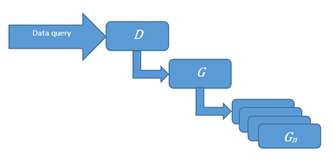
Figure 1: Diagram of the Data Query and Classification Process (By The Authors).
The separated sets Gn have been characterised using general statistics and analysed using the TF statistics. The objective of the study was to identify the potential of graphene application and identification of potential change trends.
3. Discussion of the Results
The examined period was 01/2021-05/2022, number of sources xxx, size of the resource xxx. The collected material was classified into five areas including nanotechnology (40.65% of the resource), electrical engineering (21.14%), energy (17.68%), and biotechnologies (3.25%). The remaining part of the set, covering various topics, comprised 14.29% of the set G (Table 1). The results of the analyses indicate the potential of the tools used, but - in the described example - do not determine the selection of specific technologies using graphene, but only the growth areas. This point of view clearly indicates the potential of the tool, which increases with the increasing involvement of knowledge in a specific, specialised field (in this case, related to the ‘macrocategory’ of graphene - namely nanotechnologies). If we exclude the higher order - ordering category of nanotechnology, it turns out that categories with potentially quite wide graphene applications may be found in the other categories. It seems that basic applications, studied for years, may utilise the promising properties of this material in energy-related solutions. Research dedicated to applications in the widest of categories, that of electric engineering, includes not only batteries, but also transistors, magnetic field sensors, fuel cells, electric conductors and current generators. Studies on graphene, related to its use in the production of batteries, optical sensors or as a membrane used in water desalinisation, are perceived as promising and future-oriented. Many applications in medicine, such as biomarkers, oncological therapies or targeted drug delivery may also have significant potential in terms of their practical use.
|
Technology |
Total |
|
nanotechnology |
40.65% |
|
electrotechnology |
24.14% |
|
Energy |
17.68% |
|
Biotechnology |
3.25% |
|
Other |
14.29 % |
Table 1: Technologies Related to the Use of Grapheme.
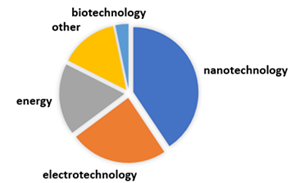
Figure 2: Technologies Related to the Use of Grapheme.
Thus, the size of the set including nanotechnologies using graphene comprises the biggest part of the studied corpus G. As the statistical description indicates, nanotechnologies are the biggest area in which graphene is used and it seems that this particular area holds the biggest potential for its practical applications. Nanoribbons, nanotubes, nanoplateles, nanosheets and nanoribbon are the first five most frequently mentioned terms - nanotechnology products - in the context of applications. Nanoporous, nanochannel and nanowires are the last identified and significant use of nanotechnology.
|
Item |
Nanotechnologies |
Nanotechnology |
|
1 |
Nanoribbons |
nanoribbons |
|
2 |
Nanotubes |
nanotubes |
|
3 |
nanoplatelets |
nanoplatelets |
|
4 |
nano-sheets |
nanosheets |
|
5 |
nanoribbon |
nanoribbon |
|
6 |
nanoparticles |
nanoparticles |
|
7 |
nanomaterials |
nanomaterials |
|
8 |
nanocomposites |
nanocomposites |
|
9 |
nanostructures |
nanostructures |
|
10 |
nano-porous |
nanoporous |
|
11 |
nanochannel |
nanochannel |
|
12 |
Nanowires |
nanowires |
Table 2: The Most Frequently Cited Nanotechnologies.
Electrical engineering, comprising the second largest area of graphene use, includes primarily the fields of electricity, electrode and electronics. The most frequent applications for graphene also include electrochemistry and electrostatic. The list of the twelve most commonly used electrical technologies using graphene is finally completed with electrophysiology, electromechanics and electrooculography.
|
Item |
Electrical Engineering |
Electrotechnology |
|
1 |
electricity |
electricity |
|
2 |
Electrode |
electrode |
|
3 |
Electronics |
electronics |
|
4 |
electrochemistry |
electrochemistry |
|
5 |
electrostatic |
electrostatic |
|
6 |
Electrolyte |
electrolyte |
|
7 |
Electrocatalysts |
electrocatalysts |
|
8 |
electrodynamics |
electrodynamics |
|
9 |
Electrospinning |
electrospinning |
|
10 |
electrophysiology |
electrophysiology |
|
11 |
electrical mechanic |
electromechanics |
|
12 |
electrooculography |
electrooculography |
Table 3: The Most Frequently Cited Electrical Technologies.
The technologies related to the power sector are dominated by the direct use of graphene in energy generation (graphene is usually present together with terms such as energy, power, atom and battery). The use of graphene also applies to energy media (gas, fuel, oil). Graphene also appears in the context of the Fukushima power plant.
|
Item |
Energy |
Energy |
|
1 |
power |
power |
|
2 |
energy |
energy |
|
3 |
atom |
atom |
|
4 |
battery |
battery |
|
5 |
gas |
gas |
|
6 |
fuel |
fuel |
|
7 |
oil |
oil |
|
9 |
motors |
engines |
|
10 |
Fukushima |
Fukushima |
Table 4: The Most Frequently Cited Energy Technologies.
Although biotechnologies comprise a relatively small area of graphene applications, seem to be the most varied one and the graphenes used in them are as different. Graphene is mentioned here in the context of, inter alia, bioanalysis, biocatalysts, biocarbon or biochemistry (which may comprise a separate area of interests in itself). The occurrence of graphene together with biodegradation or biodistribution is promising, in particular in relation to the current green trends.
|
Item |
Biotechnologies |
Biotechnology |
|
1 |
bioactive |
bioactive |
|
2 |
bioanalysis |
bioanalysis |
|
3 |
biocarbon |
biocarbon |
|
4 |
biocatalyst |
biocatalyst |
|
5 |
biochemistry |
Biochemistry |
|
6 |
biocompatibility |
Biocompatibil |
|
7 |
biocomposite |
Biocomposite |
|
8 |
bioconjugate |
Bioconjugate |
|
9 |
biodegradation |
biodegradation |
|
10 |
biodistribution |
biodistribution |
|
11 |
bioelectric |
Bioelectrical |
|
12 |
bioelectron |
Bioelectron |
Table 5: The Most Frequently Cited Biotechnologies.
|
Nanotechnology |
Electrotechnology |
Energy |
Biotechnology |
Other |
|
|
01/2021 |
42.62% |
17.86% |
18.42% |
5.20% |
15.89% |
|
02/2021 |
38.17% |
28.09% |
12.90% |
5.24% |
15.59% |
|
03/2021 |
32.57% |
27.79% |
15.74% |
2.79% |
21.12% |
|
04/2021 |
32.54% |
35.15% |
12.81% |
1.70% |
17.80% |
|
05/2021 |
45.97% |
15.95% |
19.38% |
1.03% |
17.67% |
|
06/2021 |
39.74% |
27.29% |
19.43% |
2.62% |
10.92% |
|
07/2021 |
50.97% |
13.13% |
11.78% |
3.28% |
20.85% |
|
08/2021 |
49.17% |
20.81% |
18.05% |
3.50% |
8.47% |
|
09/2021 |
35.74% |
23.15% |
30.74% |
2.59% |
7.78% |
|
2021-10 |
28.20% |
34.73% |
18.02% |
6.53% |
12.53% |
|
2021-11 |
44.58% |
21.06% |
19.63% |
2.25% |
12.47% |
|
2021-12 |
47.48% |
16.86% |
23.06% |
3.10% |
9.50% |
|
01/2022 |
36.51% |
23.88% |
23.36% |
2.60% |
13.67% |
|
02/2022 |
36.70% |
36.09% |
14.37% |
4.28% |
8.56% |
|
03/2022 |
42.12% |
25.21% |
21.20% |
3.15% |
8.31% |
|
04/2022 |
44.85% |
21.45% |
12.81% |
4.46% |
16.43% |
|
05/2022 |
54.14% |
19.19% |
13.13% |
2.63% |
10.91% |
Table 6: Percentage Distribution of Graphene Use Areas.
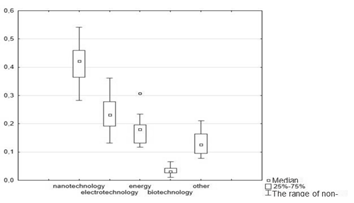
Figure 3: Characteristics of Graphene Application Areas.
The graph presented above shows the median value for the analysed keyword - technologies as a measure of the central value and of the variability measure. The variability measure for keyword occurrence is represented by a box describing the midpoint - the median. The bars above and below the box describe the measure of variability for non-deviating values. If we exclude nanotechnology, which is a grouping ‘master’ variable for graphene, from the graph, the main application areas of graphene can clearly be seen - as non-deviating values for individual keywords. The most important of these may probably be technologies related to the terms of energy and electric engineering used as keywords. In the case of the ‘energy’ term, extreme values appear on the graph, significantly above the second quartile (a similar situation occurs in the case of technologies, which are defined here as ‘other’). In the latter case it is likely that we are talking about specialised medical technologies, although a confirmation of this point requires additional research. By analysing the profile of the graph describing the two key technologies (most frequent in the context of graphene) - nanotechnology and electric engineering, we can see emerging, interesting relationships related to the environment, which we believe should not have such a significant impact on the profile of the graph. Chances are this may be only an apparent relationship, or a relationship resulting from non-obvious applications of graphene or technologies related to graphene for military purposes. An increasing trend can be observed for nanotechnology ever since the war in Ukraine broke out, while electric technologies display a faster, decreasing trend. China is one of the major global players in graphene research, thus, can the graphs presented below indicate a change in involvement of laboratories of this country in R&D&I processes related to the use of graphene nanotechnologies for purposes previously marginal from the point of view of the research? The trend shown - if sustained - could mean that new areas could be discovered for graphene-related research.
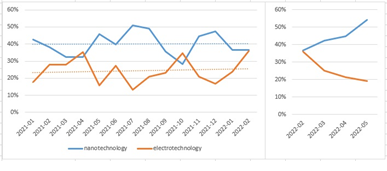
Figure 4: Nanotechnologies, Electric Technologies in 2021 And In 2022 (after the Outbreak of War in Ukraine).
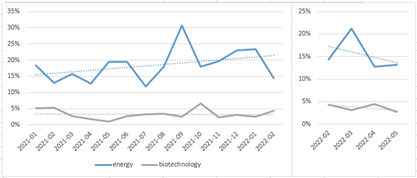
Figure 5: Interest in Graphene Applications in the Power Sector and in Biotechnology.
At the same time, an analysis of technologies related to the use of graphene in the fields such as energy, optics and biotechnology - a decreasing tendency of the analysed trends can be observed in all cases. This is most evident in the case of energy-related applications. The initial rise of the trend and the growth of research on the use of graphene in the power-related solutions has been broken and the decreasing trend is obvious and extreme since the war in Ukraine began. In the two other cases - optics and biotechnology - the decreasing trend has already been present throughout 2021, and has been maintained after the war broke out. Further research analysing in detail the variables describing the potential impact of the global security on the development of graphene technologies in order to identify the cause behind such tendencies and, at the same time, to clearly describe it. Certain working hypotheses can be accepted, however - with the difficulties in finding potential, practical applications of graphene in mind and with the emerging requirements related to funding of military projects, graphene technologies are (at least currently) impeded. It may have been the case that the funds required for military research may be very quickly “found” in studies on optical and biotechnological applications of graphene. This hypothesis is further supported by other facts, inter alia, by the use of the so-called reverse engineering technique used to analyse the widely advertised, “breakthrough” products free of graphene.
2021 was a special year because of the tragedy of the Covid-19 pandemic. Given the social, political and economic pressures, it seems plausible that the interest in medical technologies and therefore in publications on graphene applications in medicine and in related fields may have been driven by this factor.
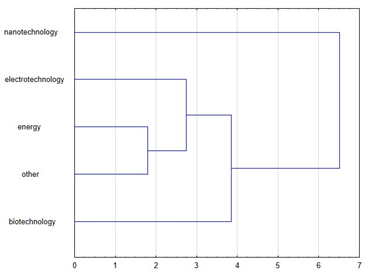
Figure 6: Graphene Application Areas - Concentration Analysis.
The correlations between the graphene application areas are interesting. Electric engineering and nanotechnologies display a strong negative correlation (-0.82). This means that increasing attention dedicated to nanotechnology is accompanied by a decreased interest in electric engineering (and vice versa). At the same time, the slightly increasing trend of interest in nanotechnologies and a much stronger (and also increasing) trend of interest in electric engineering draws attention in 2021. A much more profound change is taking place in 2022, with interest in nanotechnologies clearly on the rise since February, contrary to the sharp decline of interest in electric engineering.
The remaining correlations confirm statistical relationships which are weak and pose difficulties in interpretation.
Table 7: Correlations between Technologies Using Graphene (2021-2022)
The co-occurrence of the keywords electric engineering, as well as electric engineering and biotechnology with graphene indicates the types of potential applications, e.g. as sensors.

Figure 7: Number of Patents for Technologies (Products) Using Grapheme.
The highest levels of patenting, measured by the number of patents, is already behind graphene. This may be caused by the disappointment, typical for the development of new materials, already indicated earlier, i.e. by the lack of tangible commercial effects and, on the other hand, by the patentable, simple applications of the material running out. We do not know the impact of the forced periods of remote work (work with graphene involves laboratory work) caused by the pandemic.
4. Summary and Conclusions
The results of the analyses indicate the potential of the used technological trend analysis tools based on the big data methodology and of supervised machine learning. The described example also shows that the applied method - while extremely helpful in identification of tendencies and trends - requires additional, specialised knowledge related both to nanotechnology, as well as to (not obvious) applications of solutions based on graphene, including (probably) military purposes. The tools we used indicate the significant relationships and enable determination of the interest of researchers in graphene technologies, but do not determine the selection of specific technologies in which graphene is used, indicating important scientific development areas. This point of view clearly indicates the potential of the tool, which increases with the increasing involvement of knowledge in a specific, specialised field (in this case, related to the ‘macrocategory’ of graphene - namely nanotechnologies). It appears that the basic applications, studied for years, may use the promising properties of this material in energy-related solutions - research dedicated to applications in the widest of categories, that of electric engineering, includes not only batteries, but also transistors, magnetic field sensors, fuel cells, electric conductors and current generators. Studies on graphene, related to its use in the production of batteries, optical sensors or used in water desalinisation technologies, are perceived as promising and future-oriented. Many applications used in medicine, including oncological therapies or targeted drug delivery, may also have significant potential in terms of practical application.
References
- Novoselov KS, Geim Ak, Morozov SV, et al. Electric Field Effect in Atomically Thin Carbon Films. Science 306 (2004): 666-669.
- Saito R, Fujita M, Dresselhaus G, et al. Electronic Structure of Graphene Tubules Based on C60. Physical Review. B, Condensed Matter 46 (1992): 1804-1811.
- Van Noorden, Richard. Production: Beyond Sticky Tape. Nature 483 (2012): S32-33.
- Jin, Lin, Kuddannaya Shreyas, Wang Zhenling, et al. Fabrication, Characterization, and Biocompatibility of Polymer Cored Reduced Graphene Oxide Nanofibers. ACS Applied Materials & Interfaces 8 (2016): 5170-5177.
- Luan, Xiaoli. Heating Properties of Graphene Oxide Nanosheets and Their Application in Clothing Design. Advances in Materials Science & Engineering (2022): 1-11.
- Poszwa A. Electron Transport Properties of Graphene Quantum Dots with Non-Centro-Symmetric Gaussian Deformation. Scientific Reports 12 (2022): 1-10.
- Park, Seongjun. The puzzle of graphene commercialization. Nature Reviews Materials 1(2016): 16085.
- Martins, Lívia Salles, Lucas Fonseca Guimarães, et al. Electric Car Battery: An Overview on Global Demand, Recycling and Future Approaches towards Sustainability. Journal of Environmental Management 295 (2021).
- Kovtun, Alessandro & Treossi, Emanuele & Mirotta, Nicola & Scidà, et al. Benchmarking of graphene-based materials: real commercial products vs. ideal graphene. 2D Materials 6 (2019).
- Kong, Wei, Hyun Kum, et al. Path towards Graphene Commercialization from Lab to Market. Nature Nanotechnology 14 (2019): 927-938.
- Chaturvedi, Amit, and Patit Paban Kundu. Nanostructured Graphene Utilization in Microbial Fuel Cells for Green Energy and Wastewater Treatment: Recent Developments and Future Perspectives. Journal of Hazardous, Toxic & Radioactive Waste 26 (2022): 1-10.
- Murphy, Justine. Graphene: The ‘Wonder Material’: Innovative Discoveries Have Helped to Overcome Existing Challenges When Using Graphene. Laser Focus World 58 (2022): 42-45.
- Islam, Nazrul. Crossing the Valley of Death-An Integrated Framework and a Value Chain for Emerging Technologies, in IEEE Transactions on Engineering Management 64 (2017): 389-399,
- Cetera, Wieslaw, Wlodzimierz Gogolek, et al. Potential for the use of large unstructured data resources by public innovation support institutions. J Big Data 9 (2022): 46.
- Carbon Queen. The Remarkable Life of Nanoscience Pioneer Mildred Dresselhaus. Publishers Weekly 268 (2022): 99.
